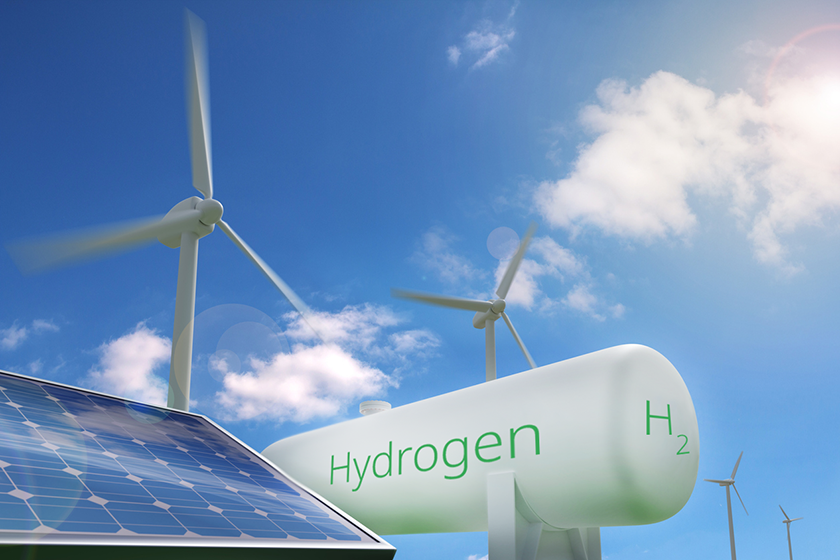In the evolving geopolitical landscape, energy security has emerged as a critical concern for India. The urgent need for clean and alternative energy sources positions green hydrogen as a strategic solution. This study examines the feasibility of green hydrogen in India, taking into account water scarcity, renewable resource availability, and infrastructure gaps. Through policy analysis and international data (IEA, NITI), it assesses hydrogen’s potential to enhance strategic autonomy, reduce import dependency, and support sustainable industrial growth. Green hydrogen as a strategic fuel, though cost-intensive, presents a long-term pathway for India’s energy transition and diplomatic leverage in the global energy market.
Introduction
Energy security refers to the continuous, affordable, and reliable access to energy resources necessary to support a nation’s economic growth, development, and national security. India’s energy security has become a significant issue in its national security and foreign policy, primarily due to increasing energy demand and a heavy reliance on imported fossil fuels. As the third-largest energy consumer in the world, India’s total primary energy demand is projected to double by 2040, with fossil fuels currently making up over 75% of its energy mix (International Energy Agency [IEA], 2021:15). Notably, over 86% of India’s crude oil requirements are met through imports (Ministry of Petroleum and Natural Gas [MoPNG], 2023; Prasad 2024). This dependence makes the economy particularly vulnerable to fluctuations in global prices, supply disruptions, and geopolitical issues in key supplier regions, such as the Middle East.
To address these challenges, India is working to diversify its energy sources, with a strong emphasis on clean fuels such as green hydrogen. Green hydrogen, created through electrolysis powered by renewable energy, presents a carbon-neutral option that can help reduce emissions in industries like refining, steel, fertilisers, and long-distance transport. As per NITI Aayog (2022), green hydrogen could fulfil 12-13% of India’s total energy demand by 2050. Acknowledging its importance, the Government of India introduced the National Green Hydrogen Mission in January 2023, aiming for an annual production of 5 million metric tonnes (MMT) of green hydrogen by 2030 and aspiring to make India a global leader in hydrogen production and exports (Ministry of New and Renewable Energy [MNRE], 2023).
Review of Literature
The Imperative for Green Hydrogen: Energy Security and Decarbonization
Green hydrogen offers a compelling pathway to mitigate these vulnerabilities. Defined as hydrogen gas produced through the electrolysis of water using exclusively renewable energy sources such as solar, wind, or hydropower, it is a truly zero-carbon fuel (IEA, 2023). Its primary byproduct, water vapour, highlights its environmental credentials. Beyond its clean nature, green hydrogen holds the potential to profoundly decarbonise challenging industrial sectors, such as steel, shipping, and aviation, which are difficult to electrify directly. Furthermore, its implementation is projected to yield substantial economic benefits for India, potentially cutting crude oil imports by 30% by 2040 and generating annual savings of ₹1,00,200 crore by 2030 (NITI Aayog, 2022). This strategic fuel can be directly burned or utilised in fuel cells, offering a versatile and emission-free alternative to traditional energy sources.
Research Gap
India has a significant study deficit on the lifecycle emissions, cost-parity timelines, infrastructure, and safety of green hydrogen for hard-to-abate sectors, as well as its geopolitical implications for international energy commerce.
Research Questions
- How does green hydrogen replace crude oil and become a strategic fuel for India? Is it sustainable and accessible? Is it cost-effective and feasible for everyone?
- How effective and strategically useful is green hydrogen in comparison to other renewable energy sources?
Research Objectives
- To investigate how green hydrogen might help India with its energy security issues.
- To assess India’s present approach to infrastructure, international involvement, and hydrogen production.
- To determine India’s hydrogen mission’s obstacles and policy deficiencies.
Methodology
Our research design was qualitative and analytical, and we used secondary data from: International agencies such as the IEA, NITI Aayog, MNRE, and MoPNG have released reports. National Green Hydrogen Mission (NGHM) and other national policies. Examples of India’s partnerships with nations like Japan, Germany, and Australia. Academic publications and briefings on energy policy. To identify best practices and areas for innovation, we also contrasted India’s hydrogen initiatives with international norms.
Hydrogen as a Transitional Fuel
Sustainable Production: Only when hydrogen is created using low-carbon energy and properly managed resources can it be considered really “green.” India is making significant investments in green hydrogen electrolysis using its enormous renewable capacity, which stands at 180 GW installed with a target of 500 GW by 2030 (ANI 2025). Water security is supported by non-potable sources like wastewater and seawater, while policies like the NGHM encourage renewable electrolysers. Even at 4% humidity, a study showed that a hygroscopic electrolyte could extract moisture from dry air with 95% Faradaic efficiency (Guo, J., Zhang, Y., Zavabeti, A. et al. 2022). India is also investigating blue hydrogen and biohydrogen, both of which have trade-offs between emissions and scalability.
Feasibility of Atmospheric Hydrogen: Since atmospheric hydrogen is present in trace levels, direct capture is not feasible. However, using hygroscopic electrolyte modules, Melbourne’s “Direct Air Electrolyser (DAE)” prototype passively collects humidity, generating around 3.7 m³ of H₂ per day per m² at a mere 4% relative humidity. Because it doesn’t need additional energy to collect water, it can produce H₂ even in desert areas where freshwater is scarce. Although encouraging, scalability necessitates sorbents, substantial infrastructure, and interaction with wind and solar fields. For large-scale projects, surface, groundwater, or desalinated seawater are chosen over commercial atmospheric H₂ plants, which are yet unavailable (Revolution Aero. (2022, September 15). Hydrogen from humidity: World-first Direct Air Electrolyser.)
Infrastructure Challenges for Green Hydrogen Integration in India
The most pressing infrastructural hurdle lies in scaling up electrolysis capacity, which is essential for producing green hydrogen. Electrolysers, the core equipment used to split water into hydrogen and oxygen using renewable electricity, remain expensive and largely imported. As of 2023, India has an estimated electrolyser capacity of less than 50 MW, against a requirement of 60–80 GW by 2030 to meet its 5 MMT green hydrogen production target (MNRE, 2023:23).
The lightest element, hydrogen, needs to be stored at 700 bar or -253°C, which necessitates specialised infrastructure and considerable energy. India uses hydrogen primarily on-site and lacks specialised pipelines and large-scale storage. While a nationwide network of hydrogen pipelines is still in the conceptual development stage, steel embrittlement hazards increase the cost of materials.
Barriers to private investment in green hydrogen include costly capital requirements, lax safety regulations, and regulatory loopholes. In 2023, the National Green Hydrogen Mission set out ₹19,744 crore for research and development, encouraging public-private collaborations through the Strategic Hydrogen Innovation Partnership (SHIP) to draw in capital and expedite technological advancement. The mission aims to draw in private investments and hasten the expansion of India’s green hydrogen ecosystem by offering financial incentives and creating a favourable governmental environment. ([Ministry of New and Renewable Energy 2023].
India develops hydrogen production technologies while collaborating internationally for advancement. Domestic enterprises are gradually progressing towards the indigenous manufacture of Proton Exchange Membrane (PEM) electrolysers and Anion Exchange Membrane (AEM) technology. In the paper “A Systematic and Critical Review of Green Hydrogen Economy in India”, a comprehensive and critical analysis of India’s emerging green hydrogen economy is provided. The study underscores the necessity for reducing electrolyser costs, fostering local manufacturing capabilities, utilising bio-hydrogen and offshore wind resources, and establishing public-private partnerships.
Fuel cells combine hydrogen and oxygen to produce heat, electricity, and water. Costs increase since most require 99.99% pure hydrogen. Solid Oxide Fuel Cells (SOFCs) for stationary use, Proton Exchange Membrane Fuel Cells (PEMFCs) for high-temperature, slow start-up problems, and tolerant designs are among the solutions. For wasted cells, strong recycling systems are necessary.
Advantages – Hydrogen’s appeal lies in its adaptability, high energy per mass, and emission-free use, producing only water. It stores renewable energy and balances grid intermittency. Hydrogen can decarbonise hard-to-electrify sectors and enhance India’s energy autonomy. Notably, India’s NGHM targets 10% of the global green hydrogen market and promises hundreds of thousands of new jobs, transforming the economy.
Disadvantages – There are serious disadvantages to hydrogen. Hydrogen faces key drawbacks. Electrolysis loses 20–30% of power, storage another 10–15%, and fuel cells 20–60%, resulting in a poor round-trip efficiency of about 30%, far below batteries. In India, green hydrogen costs ₹482–ᐨ613 per kg, requiring subsidies to compete with fossil fuels. Its high flammability demands strict safety measures. H₂ leakage worsens climate impact, with 1 tonne H₂ equalling 11 tonnes CO₂ over a century. Electrolysis uses 10–20 Lof water/kg H₂, making desalination or wastewater recycling vital in water-scarce regions like India.
Innovation and Road Ahead
Deionised water and significant renewable energy are required for the creation of green hydrogen. For this, India needs to add 125 GW of renewables by 2030. Water stress affects Rajasthan and Gujarat, which have more than 700 GW of solar potential (MNRE, 2023) and less than 1,000 m³/year per capita (NITI Aayog, 2022). Without the use of alternative sources, large-scale hydrogen projects run the risk of making shortages worse. Emerging alternatives include desalination powered by renewable energy, which is useful along Gujarat’s coastline, and treated urban and industrial effluent. In Rajasthan and Maharashtra, electrolysers that use grey water after little pre-treatment are already becoming more popular (TERI, 2023).
The MNRE initiated five pilot projects, introducing 37 hydrogen vehicles and nine refuelling stations, collaborating with major industry companies (Press Information Bureau 2025). Chhattisgarh has launched India’s inaugural hydrogen-powered fuel cell truck at the Gare Pelma III coal block. Pilot projects under NGHM are testing green hydrogen for shipping, focusing on hydrogen vessels and the required infrastructure for maritime use (Ministry of New and Renewable Energy).
To promote green hydrogen pilot trials for hydrogen fuel-cell and H₂-ICE trucks and buses, Union Minister R.K. Singh spearheaded a conference with important ministries on January 25, 2024. In addition to the current ₹496 crore NGHM grant, Singh promised more money, highlighting a national decarbonization roadmap and cost comparison with EVs. Priorities were given to continuing pilot trials and the manufacture of hydrogen technology in the country.
By redesigning its 3D lattice, Japanese researchers at RIKEN created a manganese oxide (MnO₂) catalyst for PEM electrolysers that offers a 1,000% improvement in hydrogen output over previous choices. It operated continuously for more than 1,000 hours at 200 mA/cm² and had a 40× longer lifespan. This innovation, which doesn’t require rare metals, lowers expenses, increases durability, and promotes scalable green hydrogen production.
Recommendations
- Accelerate Renewable Energy Expansion: To sustainably power green hydrogen production, India needs to install at least 125 GW of renewable capacity by 2030, with a concentration on high-potential states like Gujarat (which has 700 GW of solar potential) and Rajasthan (MNRE, 2023).
- Invest in Domestic Electrolyser Manufacturing: Domestic production facilities for PEM and AEM electrolysers should be given priority through incentives and public-private partnerships, as the current electrolyser capacity is less than 50 MW, compared to a target of 60–80 GW by 2030 (MNRE, 2023).
- Adopt Alternative Water Sources: Hydrogen projects must require the use of desalinated seawater, treated wastewater, or atmospheric moisture extraction systems with 95% Faradaic efficiency wherever possible, with India’s per capita water availability in semi-arid regions being less than 1,000 m³/year (NITI Aayog, 2022).
- Enhance the Infrastructure for Hydrogen Storage and Transportation: Create specialised facilities for storing hydrogen and pipeline networks that can withstand pressures of up to 700 bar and cryogenic temperatures of -253°C. Include safety features like anti-leak sensors and materials that can withstand hydrogen.
- Create Sturdy Regulatory and Financial Frameworks: Make green hydrogen, which is now priced between ₹482.40 and ₹613.05/kg, competitive with fossil fuels by introducing transparent, legally binding safety standards and ensuring subsidies or tax breaks.
- Promote research and development of fuel cells and inexpensive catalysts:
Encourage the development of new technologies such as fuel cells with intermediate working temperatures and lower purity hydrogen tolerance, and manganese oxide catalysts, which can increase hydrogen output 1,000% more than earlier possibilities. - Incorporate Circular Water Economies: Require that industrial and hydrogen fuel cell product water be recycled back into electrolysis operations, especially in areas with limited water resources.
- Reduce the Risk of Hydrogen Leakage: Tight emission monitoring, recovery systems, and leak detection must be implemented across the hydrogen value chain because one tonne of H₂ leakage is equivalent to the climate impact of eleven tonnes of CO₂ over a century.
Conclusion
In India’s quest for energy independence, decarbonization, and increased geopolitical might, green hydrogen stands out as a crucial element. Green hydrogen provides a practical and ecological alternative that can revolutionise industries like steel, shipping, fertilisers, and heavy transportation as the nation struggles with growing energy demands, a significant reliance on fossil fuel imports, and urgent climate goals. India is well-positioned to become a global centre for the production and export of green hydrogen thanks to the National Green Hydrogen Mission and strategic bilateral and international partnerships.
But there are several regulatory, financial, and infrastructure obstacles in the way of the shift. India must solve important obstacles, such as the high cost of electrolysers, the lack of a strong hydrogen transport and storage network, water stress, and limited domestic manufacturing capabilities. Successful integration also depends on limiting hydrogen leakage, promoting public-private innovation partnerships, and guaranteeing sustainable water use.
Notwithstanding these challenges, the potential of green hydrogen—its versatility, lack of emissions, and strategic importance—offers India the chance to not only satisfy its internal energy demands but also strengthen its position as a leader in the world’s clean energy market. To make hydrogen a pillar of India’s energy security and foreign policy strategy, a targeted, coordinated, and inclusive policy framework, technological innovation, and environmental stewardship are essential.
Title image courtesy: Plug Power
Disclaimer: The views and opinions expressed by the author do not necessarily reflect the views of the Government of India and Defence Research and Studies

References
ANI. (2025, February 24). India’s 500 GW renewable energy target by 2030 requires Rs 33 lakh crore, says M Nagaraju. The Economic Times. https://economictimes.indiatimes.com/industry/renewables/indias-500-gw-renewable-energy-target-by-2030-requires-rs-33-lakh-crore-says-m-nagaraju/articleshow/118537690.cms?from=mdr. [Accessed on 18.05.2025]
Guo, J., Zhang, Y., Zavabeti, A. et al. (2022), ‘Hydrogen production from the air.’ Nat Commun 13, 5046 (2022). https://doi.org/10.1038/s41467-022-32652-y accessed on
India Energy Outlook 2021. (2021). In the International Energy Agency. International Energy Agency, p. 15. [Accessed on 22.05.2025]
International Energy Agency. (2023). The role of hydrogen in a clean energy future. International Energy Agency. https://www.iea.org/reports/the-future-of-hydrogen [Accessed on 28.05.2025]
Japan discovers game-changing metal that boosts hydrogen output by 1,000%—the world is closer to fossil-free future. (2025, June 21). The Economic Times. Retrieved June 27, 2025, from https://economictimes.indiatimes.com/news/international/us/japan-discovers-game-changing-metal-that-boosts-hydrogen-output-by-1000world-closer-to-fossil-free-future-green-hydrogen-news/articleshow/121980338. [Accessed on 9.06.2025]
Prasad, N. (2024, April 23). India’s crude oil consumption up 4.6% in FY24, output rises marginally at 0.6%, imports steady: PPAC. Mint. https://www.livemint.com/economy/indias-crude-oil-consumption-up-4-6-in-fy24-output-rises-marginally-at-0-6-imports-steady-ppac-11713885600547.html. [Accessed on 15.06.2025]
Press Information Bureau. (2023). India’s hydrogen projects: Achievements and pilots. Government of India. https://pib.gov.in [Accessed on 20.05.2025]
Press Information Bureau. (2025, March 15). India expands pilot projects under the National Green Hydrogen Mission. Government of India. https://www.pib.gov.in/PressReleasePage.aspx?PRID=2107795. [Accessed on 24.06.2025]
Wu, L., Xu, Y., Wang, Q., Zou, X., Pan, Z., Leung, M. K. H., & An, L. (2025). Direct seawater electrolysis for green hydrogen production: electrode designs, cell configurations, and system integrations. Energy & Environmental Science. https://doi.org/10.1039/d5ee01093d [Accessed on 27.06.2025]
Revolution Aero. (2022, September 15). Hydrogen from humidity: World-first Direct Air Electrolyser. Retrieved from https://www.revolution.aero/news/2022/09/15/hydrogen-from-humidity-world-first-direct-air-electrolyser [Accessed on 28.06.2025]
Cosmos Magazine. (2022, September 2). Australian researchers make hydrogen from air. Retrieved from https://cosmosmagazine.com/technology/hydrogen-air-electrolysis[Accessed on 27.06.2025]
PV Magazine. (2022, September 8). PV-powered direct air electrolysis module to produce hydrogen from moisture in the air. Retrieved from https://www.pv-magazine.com/2022/09/08/pv-powered-direct-air-electrolysis-module-to-produce-hydrogen-from-moisture-in-air [Accessed on 27.06.2025]
Li, X., He, T., Liu, W., Qiao, S., & Wang, L. (2022). Harvesting hydrogen from the atmosphere: Recent advances and future prospects. Environmental and Health Sciences, 3(1), 127–139. https://doi.org/10.1515/ehs-2022-0127 [Accessed on 29.06.2025]
Harnessing Green Hydrogen: Opportunities for Deep Decarbonisation in India
NITI Aayog & Rocky Mountain Institute (2022). Harnessing Green Hydrogen: Opportunities for Deep Decarbonisation in India. NITI Aayog. Retrieved from https://www.niti.gov.in/sites/default/files/2022-06/Harnessing_Green_Hydrogen_V21_DIGITAL_29062022.pdf [Accessed on 30.06.2025]
“Green Hydrogen Is Critical to India’s Economic Development and Net-Zero Ambitions” (Press Release)
NITI Aayog (2022, June 29). Green hydrogen is critical to India’s economic development and net-zero ambitions: Report [Press release]. Press Information Bureau. Retrieved from https://www.pib.gov.in/PressReleasePage.aspx?PRID=1838104 [Accessed on 1.07.2025]
Shankar, A., Saini, M., & Tiwari, C. (2024, November 7). Green hydrogen – Path to decarbonization [Policy brief]. The Energy and Resources Institute (TERI). Retrieved from https://www.teriin.org/policy-brief/green-hydrogen-path-decarbonization [Accessed on 1.07.2025]
Ministry of New and Renewable Energy. (2023, January 4). National Green Hydrogen Mission. Government of India. Retrieved July 8, 2025, from https://mnre.gov.in/en/national-green-hydrogen-mission/ [Accessed on 1.07.2025]






